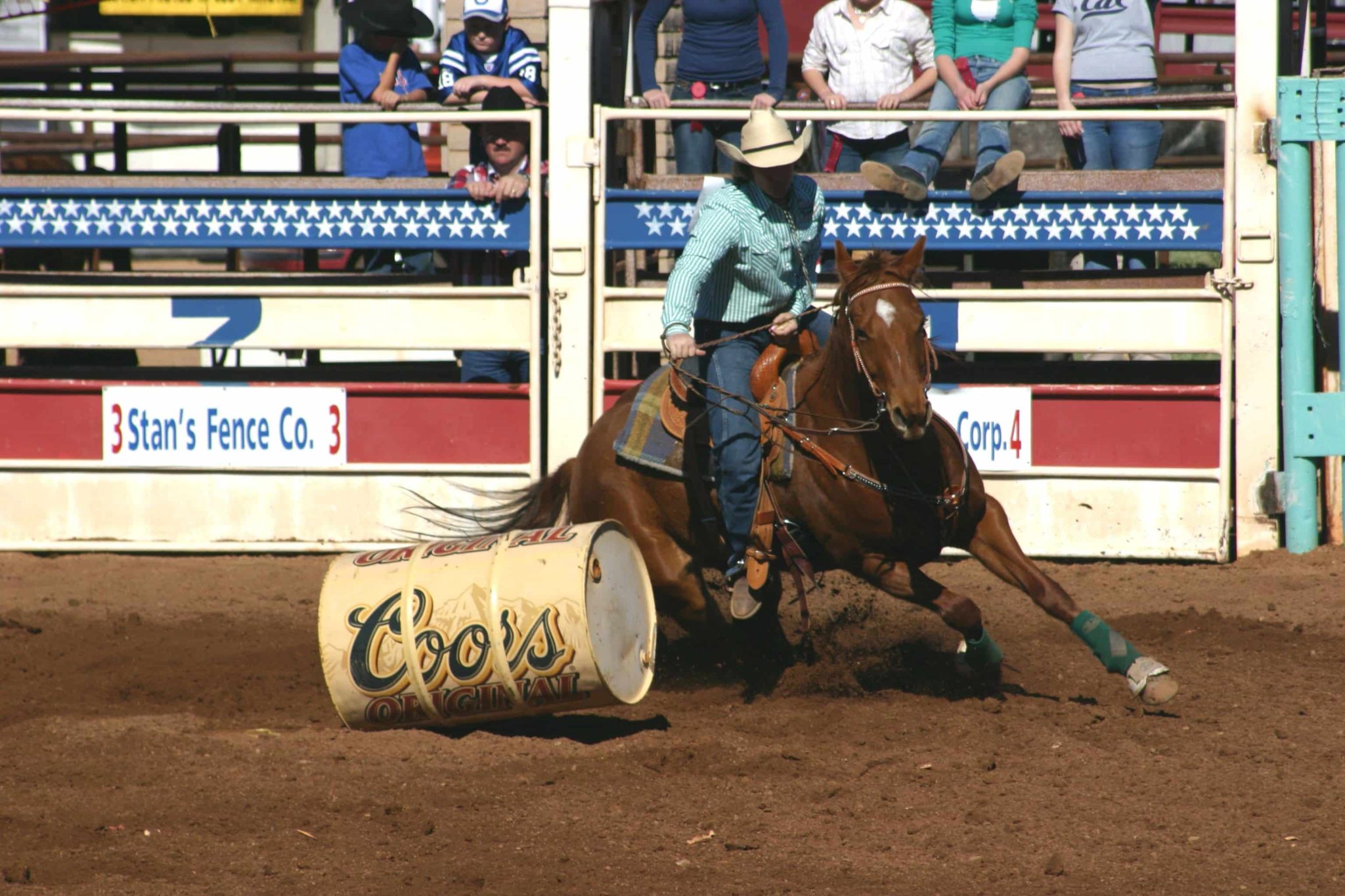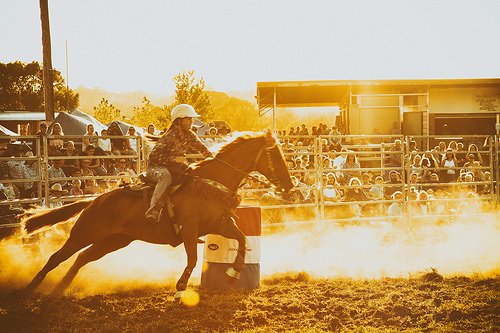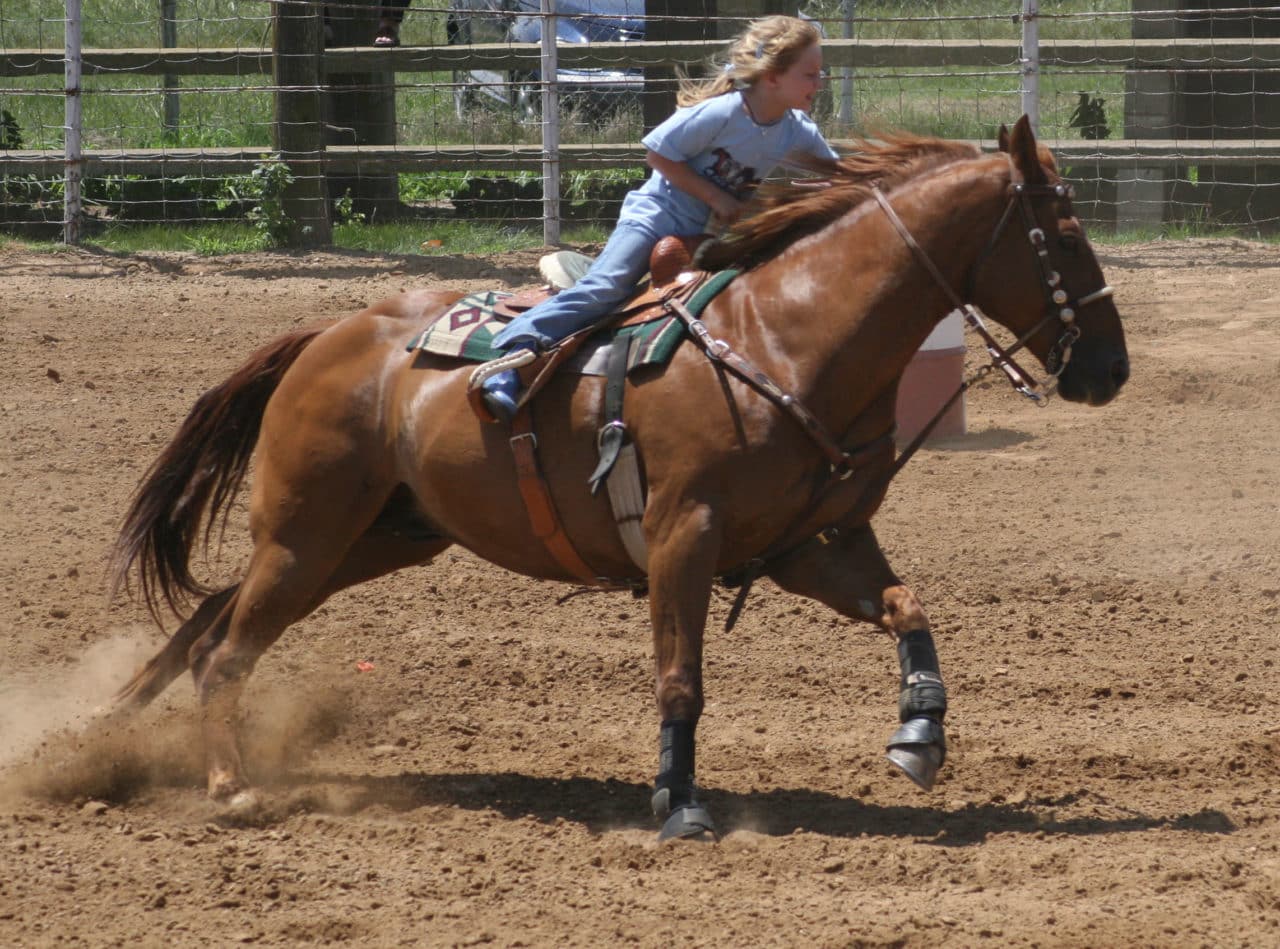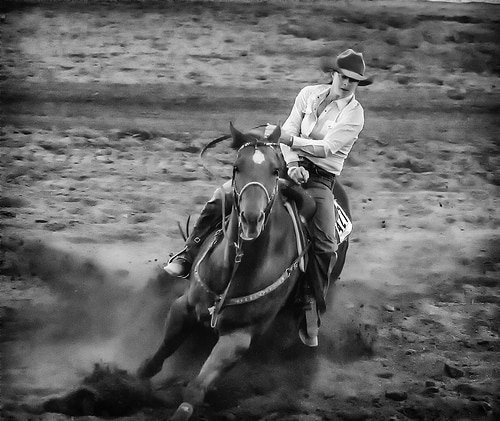
In barrel racing there are two kinds of running styles: push style and free runners. They both have their pros and cons. Push style is the more common of the two and, for many people, the easier to handle. However, free runners have more raw speed. Today we’ll look at an overview of the two styles, what makes them different, and the pitfalls and strengths of each.
The Push Style Barrel Horse

Defining Push Style
Push style horses are the ones that naturally have more rate. The moment you sit down and go for the horn they turn. Cow horse, cutting, reining, and foundation bloodlines tend to be more push style as they catty athleticism of the cow horses lends itself to natural rate. They generally need to practice things like perfect circles because their over exuberance to turn can lead to them developing habits like rolling back behind the barrel. This commonly happens when the jockey gets in the habit of pushing them too far past the barrel in an attempt to keep them from turning too soon.
Now, in my opinion, while this may look cool in competition, it really slows down your run and adds tenths to the clock as it requires a sharp change of direction that forces your horse to fight his own forward momentum. Roll back horses have a higher chance of slipping and spinning out on the hind end, much like a car will fishtail when turning sharply at high speeds. Mechanically, a round turn sets your horse up better to really get their hind end up under them, taking full advantage of the momentum they have already built up and the power that their hindquarters (engine) generates when firing at full capacity. Now, admittedly, some horses do make this work. However, I would not recommend training for this. It is a much harder turn to sit, it presents the danger of rolling back on top of the barrel, and it is harder on the horse’s hocks.
One of the biggest dangers of a push style horse is that they have a tendency to over turn and end up turning on top of the barrel. Knock a barrel and you get a five second penalty. In most races, five seconds is enough to knock you out of the competition.
My mare Moose is a push style horse. She turns so hard she peels the paint off the barrel and spins it like a top. Teaching her to respect the barrel’s personal space is a huge issue. She makes perfect circles but the circles are just too damn small if I’m not careful. Her turns are to die for, but her personal space issues make her difficult to run because everything has to be done at the exact right time with the exact right amount of pressure unless I want to crater the barrel. So while I say that push style horses tend to be easier to ride, when taken to extreme, some can be quite difficult.
Push Style Rider
This is the type of horse that is preferred by many jockeys. Barrel racing is a fasted paced adrenaline rush akin to a roller coaster. We’re essentially strapping ourselves to a half ton living rocket and praying we’re still on, alive and in one piece when it finishes the pattern. If you really think about it, it’s an exercise in stupidity, really. But I suppose that’s why we love it and why we get so into the race that we ride like banshees.
Push style horses need an active rider — hence the name push style. They need to be driven into and out of the turn. A push style horse with a reserved jockey will never clock to their fullest potential. That being said, active doesn’t mean crazy and when I say crazy, I mean starfish.
The Starfish
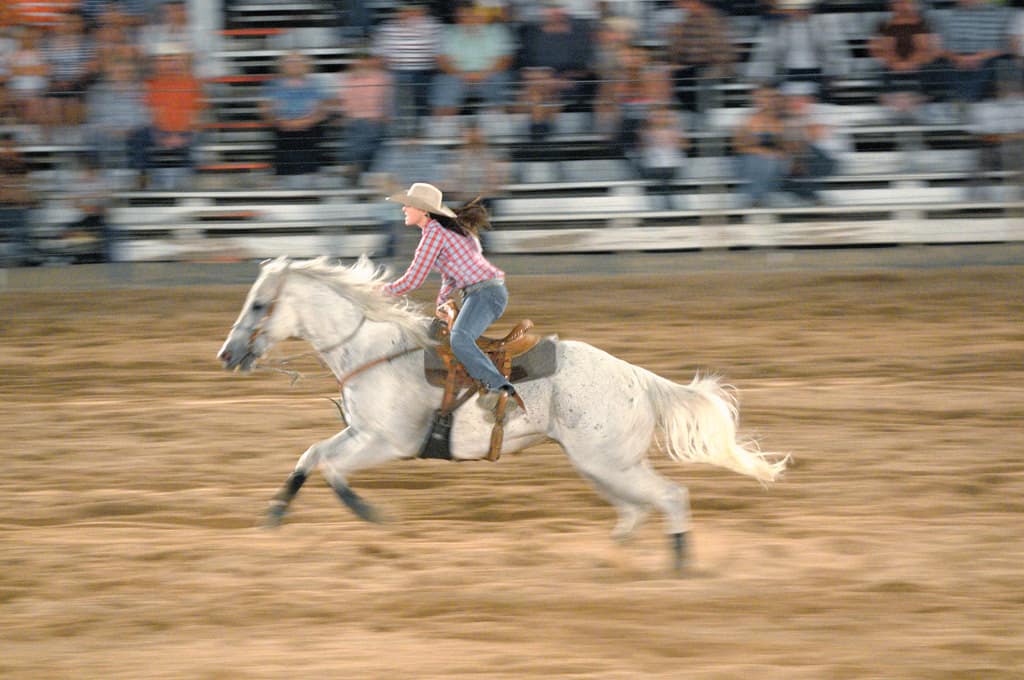
Oh yes, the S-word that every barrel racer hates. It is the catch-all scapegoat for barrel racing-haters and animal rights activists across the country. They love to comb through every frame of footage to find that one moment where daylight peaks between the rider’s posterior and the horse’s back so they can scream “starfisher!”
Sometimes they are right. Those people who really are starfishers should be ashamed of themselves, especially those who vocally defend their actions and encourage others to follow in their footsteps. It is not something to be proud of. But — there is always a but — not near every barrel racer deserves to be slapped with the ‘starfish’ label. Every barrel racer, no matter how quiet of a seat they have, will have split second somewhere in the pattern where their butt leaves the saddle just for a moment. In that sense, we are all starfishers at some point or the other, but I digress.
A true starfish is someone kicks and flails the whole way through the pattern and could fit a basketball between their butt and the saddle. They often favor whips and spurs and they’re the ones that get big air coming out of the third barrel. That is not pushing. That is flailing like a fool.
Think of it like this; have someone come up behind you and jab you in the ribs hard (both sides at the same times). Ouch! Takes your breath away a bit doesn’t it? Now imagine how the horse feels? He’s running his heart out and you’re their pounding away on his ribs taking his breath away. Think logically for a moment. Are you helping him run faster or slowing him down? Just a little food for thought.
Push Style vs Under Motivation
It is very important that we do not confuse push style horses with laziness. You would be amazed at how many “push style” horses I’ve seen who were just under motivated. A lot of times it comes from frustration. If a horse is really trying and running is heart out but he’s still getting kicked and whipped like no tomorrow, he’s not going to be very motivated to try very hard because he’s damned if does and damned if he doesn’t. If he can’t find a release point, he’ll just stop trying. I’ve seen more than one free runner give up and magically become “push style.” I’ve never actually heard of a horse changing styles between push style and free runner. If they seem to magically change sides, there is probably a good reason, be it pain, frustration, or a bit of both.
The Free Runner
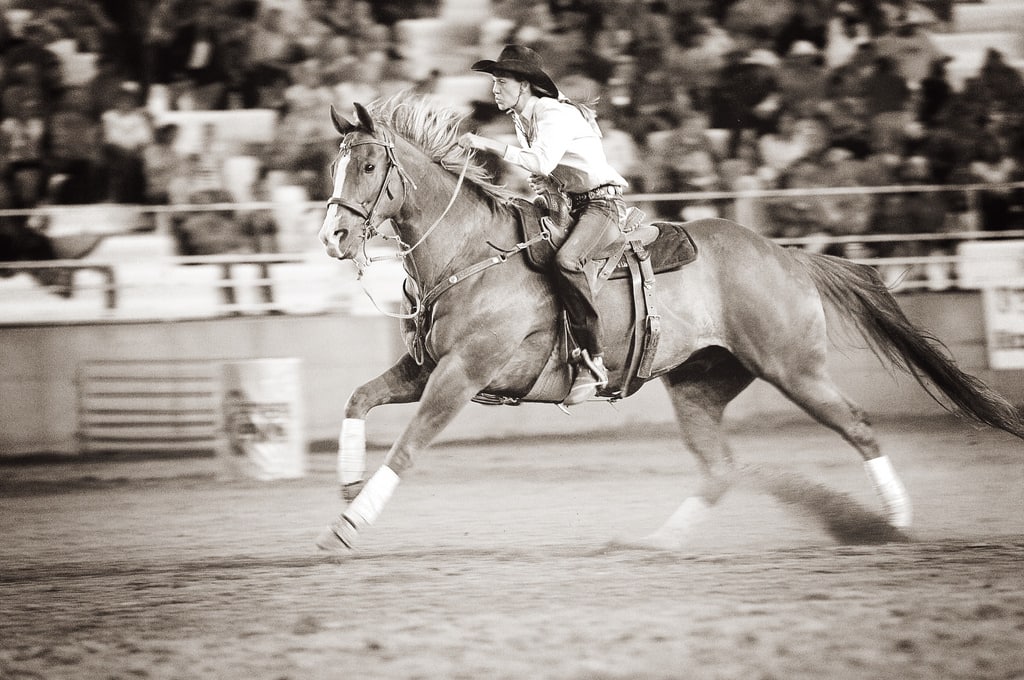
Defining Free Runner
Free runners are in the minority in the barrel racing industry. They are the horses that live for running and don’t have as much natural rate. Thoroughbreds and appendix horses tend to be free runners as they are bred for running in straight lines and their size makes them less aerodynamic. Off the track quarter horses tend to also fall in this category as they are also bred and trained for running as opposed to turning. That is not to say that they don’t make good barrel horse though. Under the right jockey a free runner can make it just as far in the sport as a ratey push style horse.
Free runners often need to cued half a stride sooner in the turn than a push style horse, requiring more set up to make the turn successfully. Free runners often have the advantage of raw speed. In a straight line the free runner will probably beat push style horse. But their speed is balanced by their handicap through the turns. Free runners lose precious tenths on the clock through their turns, enough to level the playing field for the push style horses that may not have as much raw speed through the straightaways.
Free Running Rider
The curse of the free runner is that they require a quiet rider with the athleticism to keep up with them and help them through the turns but the willingness to stay out of their way through the straight stretches. Free runners are generally harder to ride than the push style because they involve staying quiet, which, in the heat of the moment, many of us really struggle with.
Of course, here’s where the starfish really get hung up. No horse appreciates a starfish, but push style horses may be a bit more tolerant than a free runner. I’ve seen a lot of free runners shut down under starfish. Then the starfish would complain that their horse magically turned into a push style horse when really the horse lost all motivation to try because he was damned if he did and damned if he didn’t.
Free Runner vs Runaway
Too many times I see horses labeled as "free runners" when they are really just hot and out of control. A horse that bolts through the pattern and blows past the barrels is not a free runner. He's under trained and poorly ridden. A free runner still does his job and runs the pattern, he just slows down a bit more through the turns and has to make up ground on the straightaways in between. "Free running" is not a catch-all excuse for poor training and bad riding.
We must remember that horses are prey animals with a very strong fight or flight instinct. They instinctually associate running with life-threatening danger. In the wild, many predators will go in for the kill by going for the spine -- the back and the neck. When we ask them to run barrels, we are sitting on their backs and leaning forward over their necks. This puts them in a very vulnerable position while we amp them up and get all that adrenaline pumping as we race against the clock. So you see how this looks from their perspective. If your horse is not properly prepared and does not have the mental and emotional stability to handle the pressure, the likelyhood of him falling apart and bolting is very high. This how alley problems and runaways are born.
A Happy Medium
Ideally we want to find a happy medium between push style and free runner. Some horses tend toward either extreme while some horses drift towards the middle ground of the spectrum. Moose would be an extreme example of a push style horse who can strip the paint off the barrels but needs extra hustle on the straightaways. That extreme isn't necessarily common and it certainly isn't easy to ride. Ideally, as riders and trainers it is our job to balance out our horse's tendencies with structured and consistent training.
Cover Photo by Arizona Parrot






